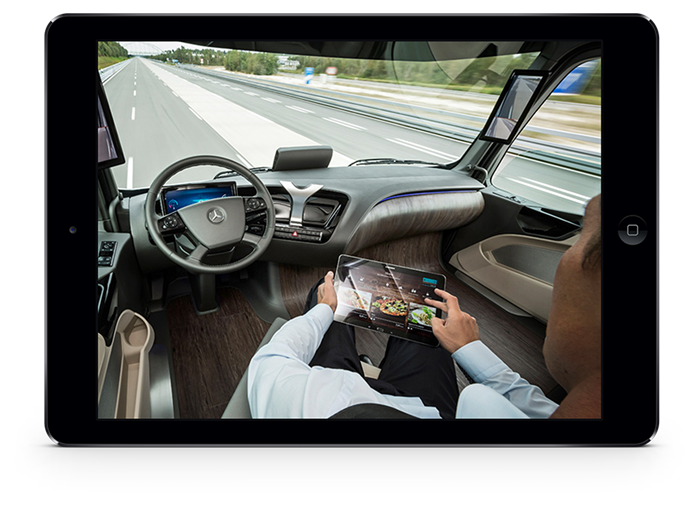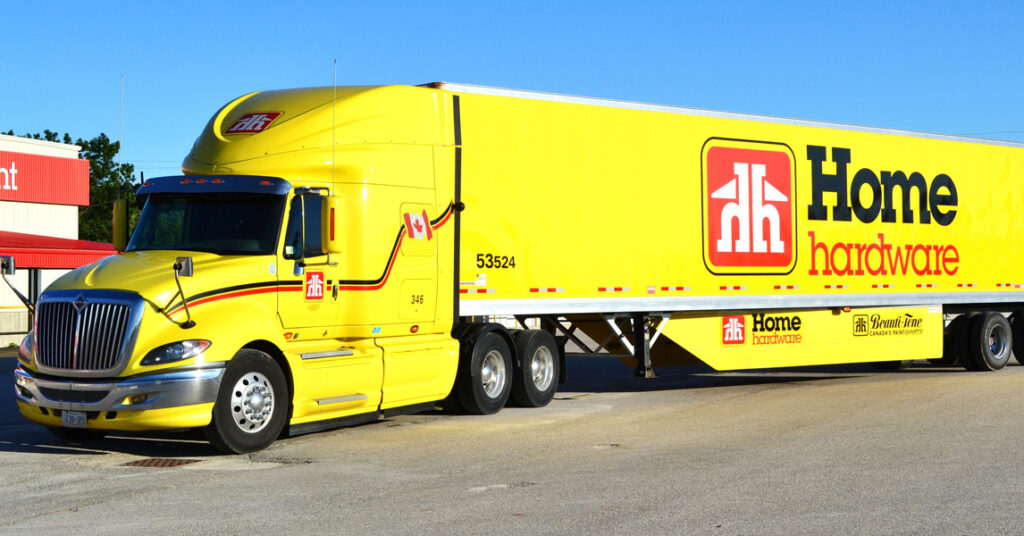Freight forward
A blend of regulatory changes and technological innovations is poised to keep Canada’s road freight flowing and economic growth happening while reducing trucking’s carbon footprint.
Figures from Environment Canada confirm the trend: the use of transportation energy by passenger vehicles is on the decline. It adds up. Cars are becoming increasingly fuel efficient. The choice of fuels is gradually expanding. Drivers are adopting new and novel techniques to use less fuel, save money and generate fewer emissions.
But hold on. There’s a flipside to those government figures. As passenger vehicles’ share of transportation energy use drops to approximately 40 percent by 2040, our reliance on truck transport continues to grow and road freight’s consumption is projected to increase from 47 to 55 percent.
So what is being done to shrink trucking’s growing share of transportation emissions? A great deal, actually.
Passenger vehicle energy use vs. freight vehicle energy use

Road freight is vital to Canada’s economy
“The trucking industry is the backbone of Canada’s supply chain,” says Steve Laskowski, President of the Ontario Trucking Association, and Senior VP of the Canadian Trucking Alliance. “Most retail items and manufactured goods are moved by truck at one time or another, and they will continue to be moved that way for the foreseeable future. That’s the reality.”
Laskowski believes that concerns about his industry’s future emissions performance are unfounded. “There are very strong business forces at work to ensure the trucking industry addresses its carbon emissions,” says Laskowski.
He points out that, after labour, fuel is a trucking company’s greatest expense. That adds up to a lot of motivation to increase freight capacity and volume while decreasing fuel use. “Even if there weren’t strong business forces at work,” he adds, “we’re committed to working with the government to help smooth the implementation of new heavy-duty vehicle standards aimed at improving fuel efficiency and cutting emissions.”
Setting high standards
The new federal, Phase 2 heavy-duty vehicle standards will come into force in 2018 and mirror those introduced by the U.S. Environmental Protection Association. By 2027, the regulations are projected to cut CO2 emissions from Class 7 and 8 tractors by 24 percent over previous standards.“The overwhelming trend is towards technological solutions to reduce emissions, whether it’s speed control, aerodynamics, alternative fuels, or upgrades to current technologies.”
The trucking industry supports these targets as long as associated carbon-reduction technologies are proven to operate safely and effectively in Canadian conditions.
Beware unintended consequences
Phase 1 of this regulatory regime led to major changes in truck engines between 2003 and 2010. Many industry members believe Phase 1 emission targets were based on unproven engine technologies. The result: nitrous-oxide and particulate-matter emissions were virtually eliminated, but faulty technologies increased vehicle maintenance costs, diminished reliability and significantly denigrated fuel economy.
There is wisdom in a blended U.S.-Canada regulatory regime given the staggering volume of freight on the move between the two countries. But to avoid unintended consequences, the trucking industry believes Canadian regulations must take into account our unique climatic and geographic conditions, as well as the major differences between Canadian and American fleets.

The trucking office of tomorrow
The value of road freight traffic between Canada and the U.S. totalled more than million in 2014. In an industry where labour is the number one expense—and a major concern as a sizable cohort of drivers retires—the lure of the driverless vehicle must be strong. Steve Laskowski thinks the primary application for this technology is in off-road fleets: at mine sites and yards where there is less interaction with passenger vehicles. “I think the first step is semi-autonomous,” says Laskowski. Volvo’s I-See software is one example. The program recognizes previously travelled routes, monitors factors such as speed, weight and engine load, keeps the truck in the most fuel-efficient gear possible, and reduces fuel costs and emissions in the process.
The first full highway application of driver assistance systems such as the Mercedes Benz Future Truck 2025 is likely to come on monotonous, major long-haul routes. With Mercedes’ Highway Pilot engaged, the driver is free to perform other business tasks, including scheduling, route planning and bookkeeping.
This offers just a hint of driverless technology’s potential impact on business models. In fact the key to greater business efficiency and road safety lies well beyond the cab in a comprehensive solution that links autonomous vehicles to each other, to freight-company logistics systems, and to the transportation infrastructure.
Photo © 2016 Mercedes-Benz

Doing it the SmartWay
Government is doing more than regulating the trucking industry. Natural Resources Canada’s voluntary SmartWay Transport Partnership works with freight carriers and shippers to reduce fuel costs while moving goods in the cleanest and most efficient ways possible. SmartWay partners—including members of the Canadian Fuels Association—benchmark their operations and track fuel consumption to improve environmental performance each year. By reducing their carbon footprint, companies are able to differentiate their operations for clients concerned about emissions.

Pit-stop performance
Home Hardware counts on the PIT Group for impartial, third-party testing of new heavy-duty vehicle technologies, including telematics and alternative fuels. PIT helps fleet managers choose the most appropriate technologies and driver-training techniques to reduce costs and improve environmental performance.
Manufacturers can submit their technologies for evaluation and refinement through PIT’s Energotest road laboratory. Successful testing lets manufacturers use the PIT Power trademark to promote the value of their products in the market. More than 270 technologies have been rigorously tested since the group was formed in Montreal in 2008.

Make sure the technology is proven
“The overwhelming trend is towards technological solutions to reduce emissions,” acknowledges Laskowski, “whether it’s speed control, aerodynamics, alternative fuels, or upgrades to current technologies.”
Dennis Shantz relies on many of these solutions. Director of Fleet Services for Home Hardware Ltd., Shantz oversees roughly 140 power units and more than 500 trailers to service 1,100 stores across Canada.
“We give a lot of thought to cutting fuel consumption and reducing our carbon footprint,” says Shantz. “Almost all our power units feature low-emission exhaust-gas recirculation (EGR) engines, which burn up particulate matter before it reaches the atmosphere.”
Many of Home Hardware’s trailers are equipped with side-skirts that have delivered fuel savings of four to six percent in recent years. The company also relies on smart route-planning strategies to optimize fuel use and minimize empty loads.
Shantz is in his 19th year with Home Hardware. He agrees it’s essential that new technologies be tested thoroughly before being brought to market. “Whenever someone tells me they’ve got something that’s going to reduce my fuel costs, I ask: has it been tested?”
Focusing on drivers
With fuel costs and GHG emissions increasing over the past 10 years, changing driver behaviours has increasingly been a focus for Home Hardware’s fleet. Onboard power-unit data shows that driver education is paying off, particularly in reducing idling times. “Our drivers have reduced idle times from 44,500 hours in 2007 to 37,600 in 2015,” says Shantz. These figures are all the more impressive considering Home Hardware’s fleet was larger in 2015 and travelled 18 million kilometres—2 million more than in 2007.“Our drivers have reduced idle times from 44,500 hours in 2007 to 37,600 in 2015.”
Meanwhile, where alternative fuels are concerned, Home Hardware’s choices are limited. “Natural gas, for example, isn’t an option for us right now,” says Shantz. “We service a lot of small towns and urban areas in Canada that are off the main routes and too far from the natural gas refuelling infrastructure.”
Making positive contributions
Regulatory incentives. Proven technologies. Smart drivers. These elements are key to reduce road freight emissions in the coming years, and ensure the trucking industry contributes not only to the ongoing economic well-being of Canada, but also to achieving the goal of a low-carbon future.
